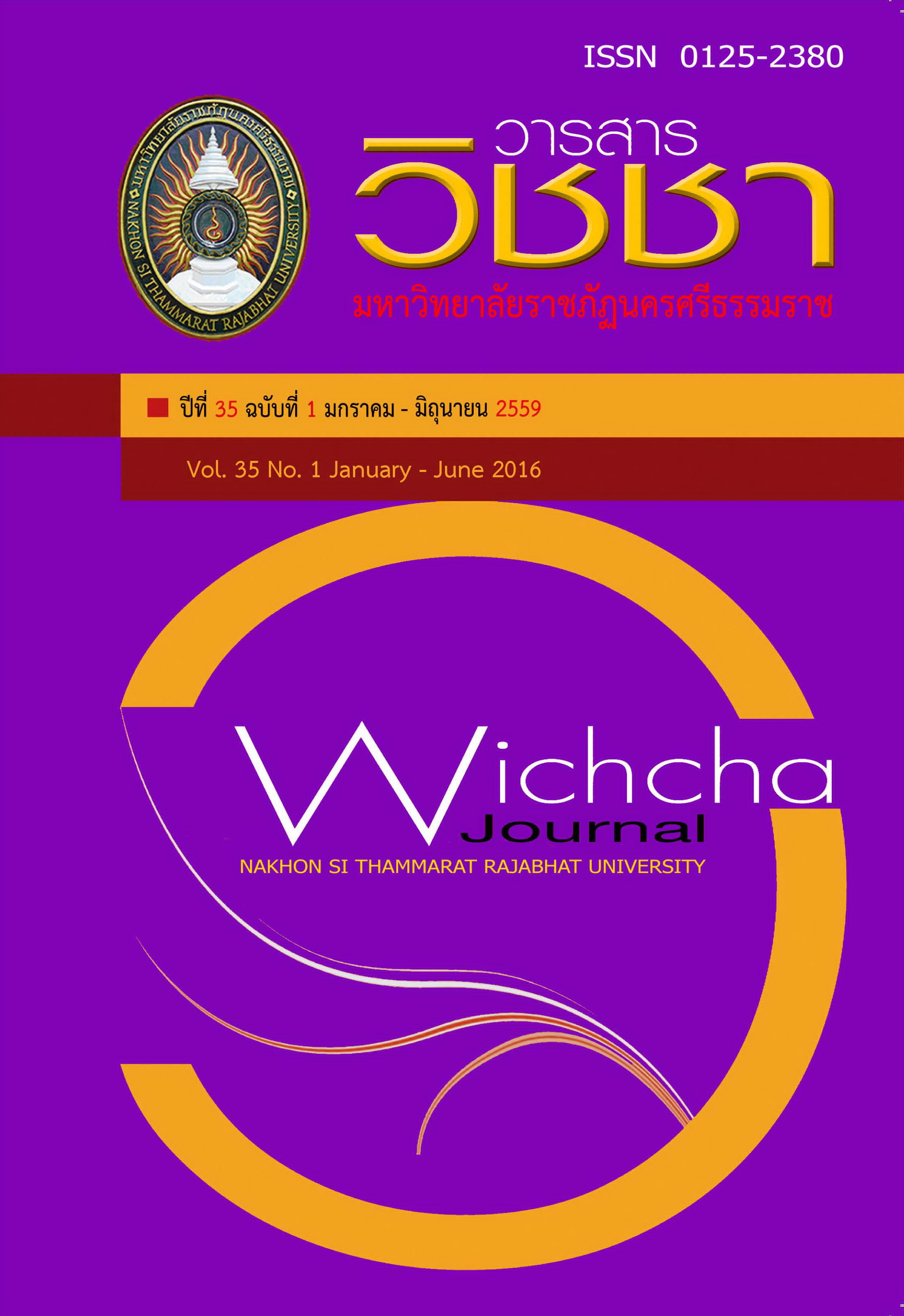การใช้ผักตบชวาแห้งเป็นอาหารสมทบสำหรับเลี้ยงปลาตะเพียนขาว
Main Article Content
Abstract
การใช้ผักตบชวาแห้งเป็นอาหารสมทบสำหรับเลี้ยงปลาตะเพียนขาว โดยการทดลองที่ 1 ศึกษาผลของปริมาณผักตบชวาแห้ง ต่อคุณสมบัติทางกายภาพและคุณค่าทางโภชนาการของ อาหารเม็ดสำเร็จรูป (โปรตีน 22-25%) ใช้ผักตบชวาแห้งในปริมาณ 0, 10, 20 และ 30 % พบว่า สูตรที่ 1, 2 และ 3 มีความคงทนของอาหารในน้ำ ไม่แตกต่างกัน แต่มีความแตกต่างจากสูตรที่ 4 (p<0.05) โดยปริมาณผักตบชวาแห้งที่เพิ่มขึ้น ทำให้ความคงทนของอาหารในน้ำ ความหนาแน่นของ อาหารลดลง แต่การดูดซับน้ำและความเป็นฝุ่น เพิ่มขึ้นตามปริมาณผักตบชวาแห้ง และทุกสูตรมีค่า การดูดซับน้ำแตกต่างกัน (p>0.05) ทั้งนี้ ปริมาณผักตบชวาแห้ง ไม่ได้ส่งผลต่อการลอยตัวของอาหาร ในน้ำ อาหารทุกสูตร มีคุณค่าทางโภชนาการอยู่ในเกณฑ์มาตรฐานอาหารสำเร็จรูปสำหรับปลากินพืช และปลาที่กินทั้งพืชและสัตว์ ดังนั้นอาหารสูตรที่มีส่วนผสมของผักตบชวาแห้ง 10% และ 20% มีคุณสมบัติที่เหมาะสมในการเลี้ยงปลากินพืชและปลาที่กินทั้งพืชและเนื้อ โดยเฉพาะปลาที่กิน อาหารระดับกลาง การทดลองที่ 2 ศึกษาผลของปริมาณผักตบชวาแห้งในอาหารสำเร็จรูปต่อการ เจริญเติบโตและอัตราการรอดของปลาตะเพียนขาว ดังนี้ สูตรที่ 1 อาหารปลากินพืช สูตรที่ 2 อาหารปลากินพืชสูตรกรมประมง สูตรที่ 3 อาหารปลากินพืชสูตรกรมประมงผสมผักตบชวาแห้ง 10% เลี้ยงปลาตะเพียนขาว ขนาด 1 ก./ตัว ยาว 5 ซม./ตัว ในบ่อซีเมนต์ 10 สัปดาห์ พบว่า อาหาร สูตรที่ 3 ให้น้ำหนักและความยาวเฉลี่ยปลา สูงสุด คือ 8.73+0.41 ก./ตัว และ 4.80+1.03 ซม./ตัว ตามลำดับ (p>0.05) กับผักตบชวาปริมาณอื่นๆ และ มีอัตราการเจริญเติบโตจำเพาะต่อวันดีที่สุด คือ 0.41+0.13 ก./ตัว ซึ่งแตกต่างจากสูตรที่ 2 (p<0.05) แต่ไม่แตกต่าง (p>0.05) จากสูตรที่ 1 นอกจากนี้ปลาที่ได้รับอาหารสูตรที่ 3 มีอัตราการรอดตาย สูงที่สุด คือ 100+0.00 % (p>0.05) แต่อาหารสูตรที่ 2 ให้อัตราการแลกเนื้อดีที่สุด คือ 0.40+0.04 (p>0.05) ดังนั้นการใช้ผักตบชวาผสม ในอาหารเพื่อเลี้ยงปลาตะเพียนขาว 10% ก็เป็นแนวทางหนึ่งในการใช้วัสดุจากธรรมชาติที่จัดว่าเป็นวัชพืชให้เกิดประโยชน์มากที่สุด
The effect of dried waterhyacinth as feed supplement for rearing silver barb was investigated in two studies. The first study was conducted to determine the effect of dried waterhyacinth levels containing fish diets on physical charateristics compared to control diet without dried waterchyacinth. It was found that the diet 4 was significantly lower (p<0.05) in water stability than diet 1 to diet3. The water stability of diets trend to decrease with increasing in dried waterhyacinth levels. The water absorption of all diets were significantly difference and trend to increase with increasing in dried waterhyacinth contents. The supplementation of dried waterhyacinth was affected to the tested fish diets by reducing the density. Besides, using higher level of dried waterhycinth resulted in decreasing the physical quality of the feed by increasing the amount of feed dust. Supplementation of fish feed with dried waterhyacinth at any levels in the diets had no effects on the buoyancy characteristics. The analysis of nutritional values found that all tested diets had nutritional values meet the requirement of diets for herbivorous and omnivorous fish. The results from this study could be concluded that supplementation of dried waterhycinth at the level of 10 and 20% in diet was suitable for herbivorous and omnivorous fish, especially, the mid-water feeder fish. The second study was investigated the level of dried waterhycinth in feed diet on growth and survival rate of silver barb. Three feed diets as commercial feed for herbivorous fish (feed 1), feed for herbivorous fish from Department of fisheries (feed 2) and feed for herbivorous fish supplemented with 10% dried waterhycinth (feed 3) were fed to silver barb (1 g average weight with 5 cm length). The results showed that the average weight gain of 8.73+0.41 g/fish and average length 4.80+1.03 cm/fish of silver barb fed with feed 3 were significantly higher (p<0.05) than those of the fish on feed 1 and feed 2. Moreover, the specific growth rate of fish fed with feed 3 was significantly higher (p<0.05) compared to the value obtained from the fish fed with feed 2. Survival rate of fish fed with feed 3 was the highest while the fish fed with feed 2 gave the lowest feed conversion ratio. From the result of this study suggested that the feed 3 was enhanced the growth rate and survival rate of fish. The utilization of 10% dried waterhyacinth as a natural replacer ingredient in fish diet provided good possibility for its application in fish farming.
Article Details
เนื้อหาและข้อมูลในบทความที่ลงตีพิมพ์ในวารสารวิชชา มหาวิทยาลัยราชภัฏนครศรีธรรมราช ถือเป็นข้อคิดเห็นและความรับผิดชอบของผู้เขียนบทความโดยตรง ซึ่งกองบรรณาธิการวารสารไม่จำเป็นต้องเห็นด้วยหรือร่วมรับผิดชอบใด ๆ
บทความ ข้อมูล เนื้อหา รูปภาพ ฯลฯ ที่ได้รับการตีพิมพ์ในวารสารวิชชา มหาวิทยาลัยราชภัฏนครศรีธรรมราช ถือเป็นลิขสิทธ์ของวารสารวิชชา มหาวิทยาลัยราชภัฏนครศรีธรรมราช หากบุคคลหรือหน่วยงานใดต้องการนำข้อมูลทั้งหมดหรือส่วนหนึ่งส่วนใดไปเผยแพร่ต่อหรือเพื่อการกระทำการใด ๆ จะต้องได้รับอนุญาตเป็นลายลักษณ์อักษรจากวารสารวิชชา มหาวิทยาลัยราชภัฏนครศรีธรรมราชก่อนเท่านั้น
The content and information in the article published in Wichcha journal Nakhon Si Thammarat Rajabhat University, It is the opinion and responsibility of the author of the article. The editorial journals do not need to agree. Or share any responsibility.


